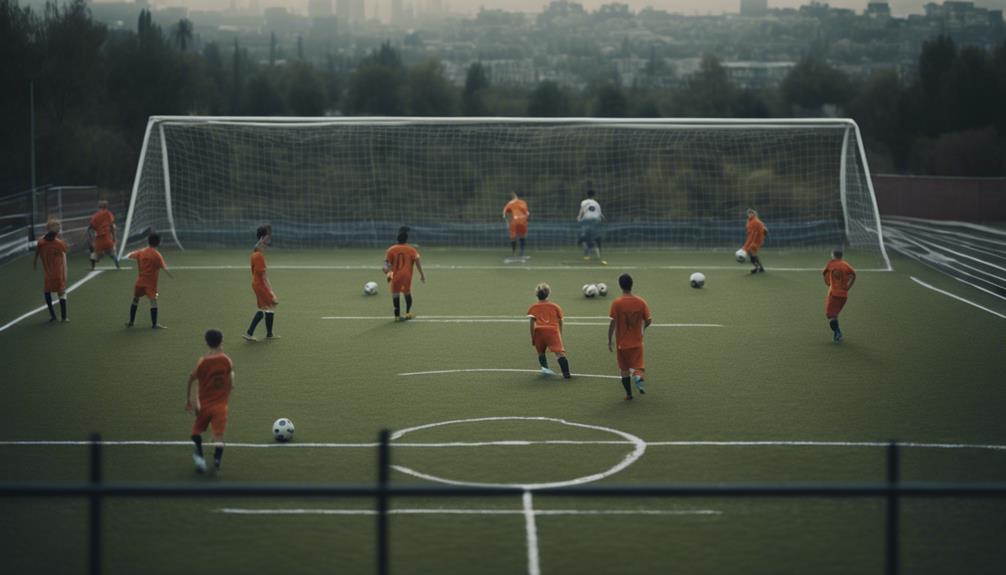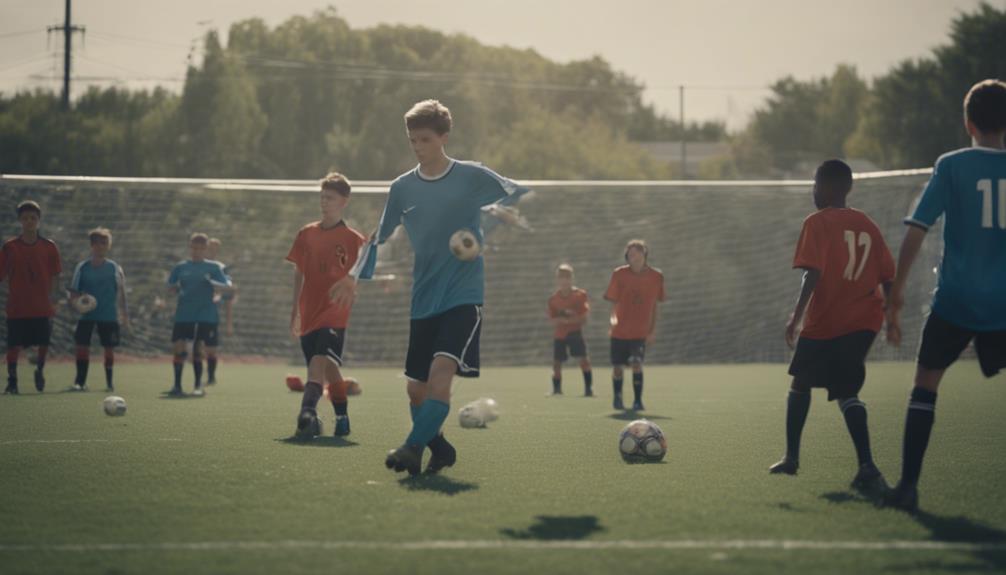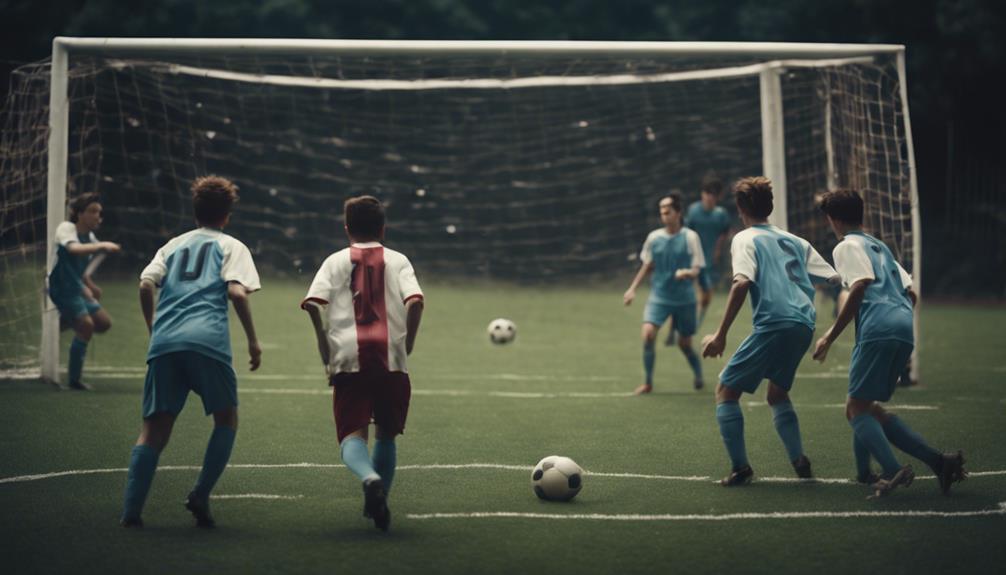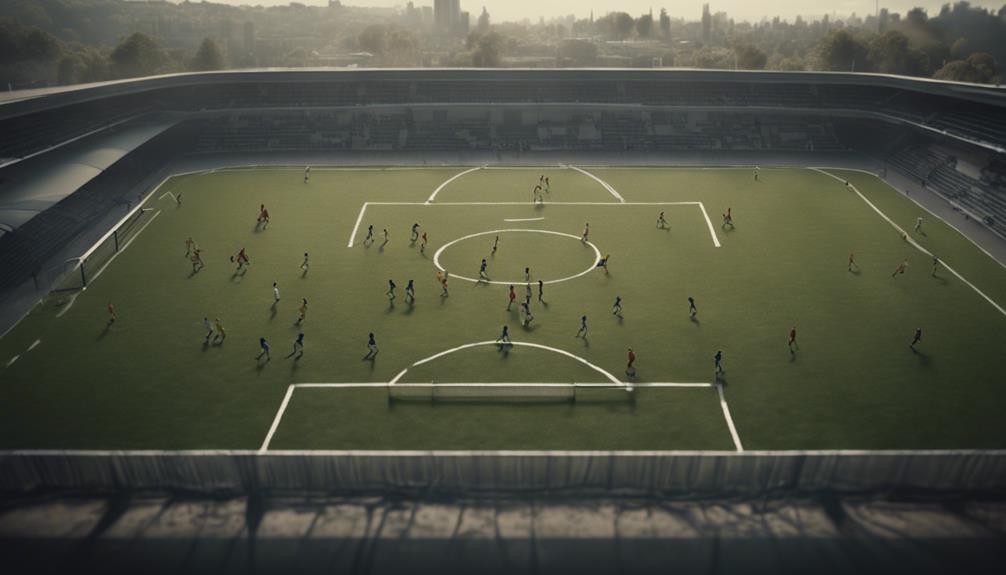
Understanding Soccer Positions in 7v7 Games
July 28, 2024To excel in 7v7 soccer games, grasp the vital roles of each position. Defenders shield your goal, midfielders control the flow, and forwards attack. Balance is key for success. Formations like 2-3-1 or 3-2-1 shape gameplay, influencing offense and defense. Encourage communication between teammates for smooth coordination. Every player contributes to the team's performance. As you understand the strategic dance of positions, challenge yourself to adapt and excel. Mastering this tactical symphony on the field is essential for victory and growth in the beautiful game of soccer.
Formations Overview
Explore various 7v7 soccer formations like 2-3-1, 3-2-1, and 2-2-2 to understand their strategic implications for offense and defense. The formation you choose can greatly impact your team's performance in both attacking and defensive situations.
For example, a 2-3-1 formation focuses on having a strong midfield presence with three midfielders supporting both the attacking and defensive aspects of the game. On the other hand, a 3-2-1 formation provides more defensive stability with three defenders while relying on two midfielders to link up play between defense and attack.
Finally, a 2-2-2 formation evenly distributes players across defense, midfield, and attack, offering a balanced approach to both aspects of the game.
Understanding how these formations work can help you make informed decisions based on your team's strengths and weaknesses. By strategically positioning your defenders, midfielders, and attackers, you can create a cohesive unit that excels in both offensive and defensive adjustments on the 7v7 soccer field.
Benefits of 7v7 Soccer
Enhancing speed and agility, 7v7 soccer offers a dynamic playing experience that fosters teamwork and skill development among players. In youth soccer, these benefits are particularly important as players are still honing their abilities and understanding of the game.
Communication plays a pivotal role in 7v7 matches, where quick exchanges of information can lead to strategic plays and cohesive team movements. The smaller team size encourages players to work closely together, emphasizing the significance of teamwork in achieving success on the field.
Moreover, skill development thrives in the 7v7 format, allowing players ample opportunities to refine essential techniques such as passing, shooting, and dribbling. The fast-paced nature of the game keeps players engaged and constantly improving their abilities.
Additionally, goalkeepers benefit from increased shot-stopping chances and distribution practice, contributing to their overall growth and confidence in the position. The tight spaces in 7v7 games also push players to enhance their ball control and make quick decisions under pressure, further enhancing their skills and adaptability on the field.
Strategic Positioning Tactics

Strategically placing yourself on the field in a 7v7 soccer game is crucial for optimizing your team's performance and effectiveness in both offensive and defensive plays. As a central defender, your placement plays a crucial role in maintaining the team's defensive shape and disrupting the opponent's attacks. By understanding passing lanes and anticipating the opponent's movements, you can intercept passes and regain possession to kickstart counter-attacks.
Proper placement not only enhances individual performance but also fosters team coordination. By maintaining the right spacing between teammates, you can support each other in both defensive and offensive phases of the game. This coordination allows for quick adjustments and cohesive plays that exploit the opponent's weaknesses.
Being aware of strategic placement tactics is key to enhancing communication on the field. Clear communication among players regarding placement helps in organizing defensive lines, marking opponents, and executing set plays effectively. By aligning your placement with your team's overall strategy, you contribute to maximizing your strengths and minimizing weaknesses for improved team performance in 7v7 soccer games.
Player Roles and Responsibilities
Let's break down the key points of player roles and responsibilities in 7v7 soccer games. Understanding each player's positional duties is vital for effective gameplay.
This guide will provide an overview of what's expected from defenders, midfielders, and forwards on the field.
Positional Roles Clarification
Understanding the specific roles and responsibilities of each player position is necessary for effective performance in 7v7 soccer games. Midfielders play a crucial role in linking defense to attack, controlling the tempo of the game, and supporting both the defense and the offense.
Communication among players, especially the central defensive midfielder, is key to ensuring smooth changes between different phases of play. Defenders are responsible for maintaining a solid defensive line, intercepting passes, and providing cover for the goalkeeper.
Forwards, on the other hand, focus on pressuring the opposition's defense, creating goal-scoring opportunities, and finishing plays. Clarifying player positions and responsibilities not only helps in organizing the team on the field but also in maximizing each player's strengths to achieve success collectively.
Responsibilities Breakdown Guide
Breaking down the duties of each player position in a 7v7 soccer game is crucial for effective team performance and coordination on the field.
Defenders are tasked with maintaining a strong defensive structure, thwarting opposing attackers, and clearing the ball out of danger zones to safeguard the goal.
Midfielders play a crucial role in creating attacking opportunities, dominating possession, and providing support in both defensive and offensive phases of the game.
Forwards carry the responsibility of pressuring the opposition's defense, making strategic runs to receive passes, and scoring goals to contribute to the team's success.
Communication among players is vital for ensuring clarity on roles, smooth shifts between phases of play, and successful execution of team strategies during the match.
Understanding the distinct roles and responsibilities of each position is essential for fostering a cohesive team dynamic and optimizing individual and collective performance on the field.
Player Duties Overview
Defenders maintain defensive structure, stop opposing attackers, and provide support to the goalkeeper in 7v7 soccer games. When understanding player duties in 7v7 matches, it's essential to grasp the specific roles each position plays in the team.
Here's a breakdown to help you navigate through the player responsibilities:
- Defenders: Their primary focus is on defense, making sure the opposition doesn't breach your team's defensive line. They must communicate effectively with teammates to maintain a solid defensive structure.
- Midfielders: These players are the engine of the team, responsible for creating attacking opportunities, controlling possession, and linking the defense with the attack. Effective communication and understanding of player positions are vital for midfielders to excel.
- Forwards: Tasked with putting pressure on the opposition's defense, scoring goals, and creating chances for the team to capitalize on. Clear communication and coordination with midfielders are key for forwards to succeed.
- Communication: Essential for clarity on responsibilities, coordination on the field, and fostering effective teamwork. Players must communicate constantly to make sure everyone is on the same page.
Youth Soccer Positions Breakdown

Let's break down the youth soccer positions to understand player roles better.
You'll get an overview of each player's responsibilities on the field.
Understanding the unique aspects of youth formations in 7v7 games is crucial.
Player Roles Overview
Understanding the breakdown of player roles in youth soccer is necessary for effective coaching and player development.
When it comes to player roles in youth soccer, several key points should be considered:
- Varied Positions: Youth soccer teams often include players in positions like goalkeeper, defender, midfielder, and forward, depending on the team size and formations used.
- Impact of Squad Size: The number of midfielders and the absence of traditional wings can influence player positioning and roles within the team.
- Importance of Positional Knowledge: Teaching young players the basics of each position, such as goalkeeper, defender, midfielder, and forward, establishes a strong foundation for their understanding of the game.
- Role Clarity: Breaking down youth soccer positions helps both coaches and players comprehend the specific roles, skills, and attributes necessary for each position on the field.
Having a thorough understanding of player roles is vital for guiding youth players effectively and nurturing their development in the sport.
Positional Responsibilities Explained
Exploring the breakdown of player responsibilities in youth soccer positions provides valuable insights into the strategic dynamics of the game.
In youth soccer, defenders are tasked with stopping opposing attacks, while midfielders play an essential role in both defense and offense by creating scoring opportunities.
Understanding these player positions is vital for coaches and players to develop a cohesive playing style and effective strategies on the field.
Additionally, players need to be versatile and adaptable to different positions to enhance their overall soccer skills and game understanding.
Teaching youth players about their positional responsibilities early on not only helps them grasp the fundamentals of teamwork and tactical play but also fosters a deeper appreciation for the strategic aspects of the game.
Youth Formation Considerations
When designing youth soccer formations for 7v7 games, consider the impact of fewer players on the field on position distribution. Youth formation considerations can greatly influence the team's performance and player development.
In youth soccer formations, you may encounter unique challenges such as the absence of traditional wing positions or having only two midfielders. To navigate these challenges effectively, focusing on the defensive structure and balance within the team is crucial.
Here are some key factors to keep in mind:
- Adaptability: Be prepared to adjust formations based on the strengths and weaknesses of your players.
- Midfield Dominance: With only two midfielders, make sure they're versatile and can cover both offensive and defensive responsibilities effectively.
- Compactness: Emphasize the importance of staying compact to maintain defensive solidity and swift adjustments.
- Communication: Encourage clear communication among players to coordinate movements and maintain a cohesive defensive structure.
Coaching Strategies for Success
Coaches in 7v7 soccer games implement various strategies to enhance player performance and team success. Understanding soccer formations, coaching strategies, player positions, and communication are fundamental aspects of coaching for success. Coaches should focus on gradually introducing new setups to players, adapting strategies to individual strengths, and analyzing player performance to optimize team dynamics.
Effective communication is key, both on and off the field. Coaches should emphasize the importance of clear communication among players to ensure smooth progressions during gameplay. Being prepared to adjust formations based on team performance and making timely changes during matches are crucial coaching tactics.
Moreover, successful coaching involves developing players' skills, providing guidance, fostering teamwork, and engaging in continuous learning. Coaches need to maintain tactical awareness, engage in strategic planning, and regularly evaluate and adjust their strategies to enhance team performance in 7v7 soccer games.
Defensive Skills and Strategies

To strengthen your team's performance in 7v7 soccer matches, refining defensive skills and implementing efficient defensive strategies is essential. When concentrating on defensive skills and strategies, consider the following:
- Defensive Formation: Select a formation that suits your team's strengths and allows for solid defensive coverage. Communicate with your teammates to make sure everyone understands their roles within the defensive setup.
- Communication: Effective communication is vital to a strong defense. Continuously talk to your teammates, providing updates on opponent movements and coordinating defensive efforts.
- Positioning: Proper positioning is pivotal in thwarting opponent attacks. Stay compact as a defensive unit, closing down spaces and limiting the opponent's options.
- Breaking up Opponent Plays: Focus on disrupting the opponent's rhythm by breaking up their plays. Anticipate passes, intercept the ball, and apply pressure to regain possession quickly.
Enhancing Player Performance
Improving player performance in 7v7 games requires optimizing individual skills for the team's overall success. Central midfielders play an essential role in linking defense and attack, requiring sharp passing and strategic vision to control the game's tempo.
Two defenders must communicate effectively, maintain a solid defensive line, and provide support to teammates when shifting from defense to attack.
Wide players need speed, agility, and the ability to deliver accurate crosses to create scoring opportunities for the team's forwards.
Enhancing player performance involves honing skills through consistent practice and feedback from coaches. By focusing on player positioning and developing qualities like decision-making under pressure, players can elevate their performance levels and contribute more effectively to the team's success.
Coaches play a crucial role in preparing players for different positions within the team structure, fostering adaptability and strategic thinking on the field.
Next Steps for Improvement

For further progress in your game, consider implementing targeted role-specific training drills to refine your skills for the 7v7 format.
To take your soccer performance to the next level, follow these steps:
- Participate in structured soccer training sessions focusing on position-based training drills to enhance your understanding and execution within your role on the field.
- Engage in tactical awareness sessions to grasp the strategic aspects of your position and guarantee you're contributing effectively to your team's overall gameplay.
- Watch professional 7v7 matches to observe how top players excel in their positions, picking up valuable insights and techniques to incorporate into your own game.
- Include small-sided scrimmage games in your training regimen to practice positional play and decision-making in a realistic, fast-paced environment, preparing you for game-day scenarios.
Conclusion
Now that you have a better understanding of soccer positions in 7v7 games, you're ready to take your game to the next level.
Remember, the field is your canvas and your teammates are your paintbrushes. Use strategic positioning, teamwork, and dedication to create a masterpiece on the pitch.
Keep practicing, keep learning, and most importantly, keep enjoying the beautiful game of soccer.
The possibilities are endless when you play with passion and purpose.


